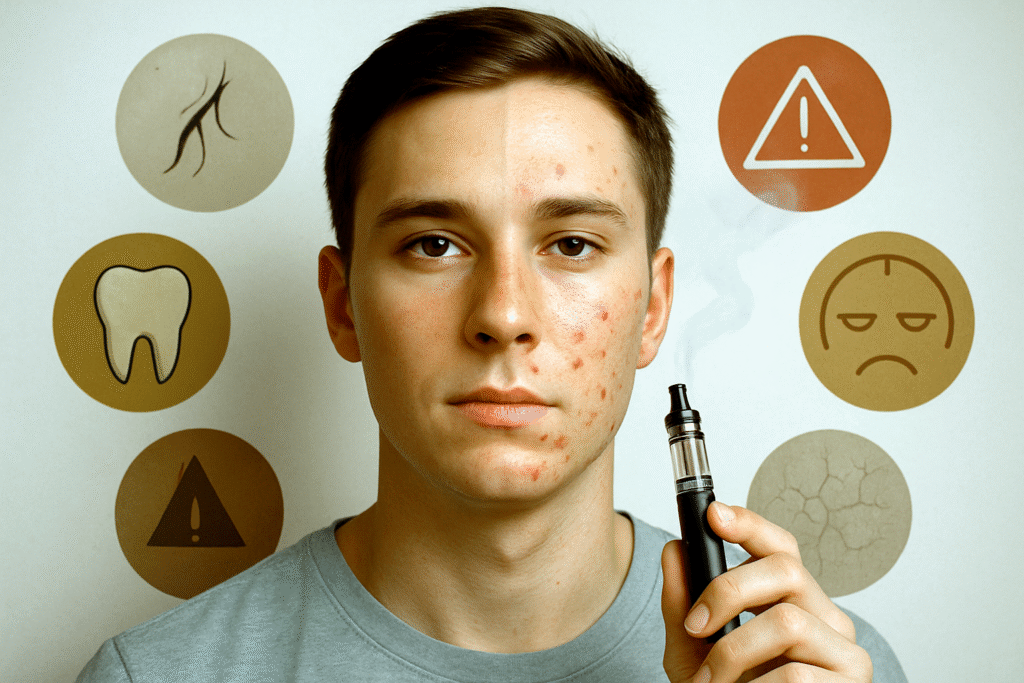Why This Question Matters
If you’ve ever looked in the mirror and thought, “Wait, why do I suddenly have breakouts?”—and then remembered you recently started vaping—you’re definitely not alone. The rise of e-cigarettes has brought along a new wave of skin-related questions. Among them: does vaping really cause acne? Or is that just another internet myth?
Acne isn’t just about clogged pores and bad luck. It’s influenced by hormones, lifestyle, diet, and even environmental factors. So it makes sense that we should examine whether vaping—a habit that delivers nicotine and other compounds—might intersect with skin health.
This guide breaks down everything you need to know: the science behind vaping and acne, what dermatologists and studies say, how ingredients in vape juice can impact the skin, and practical solutions for reducing breakouts if you vape. By the end, you’ll have clear insights and step-by-step strategies to keep your skin healthier—with no fluff or fearmongering.
Let’s peel back the vape cloud and see what’s really going on.
Does Vaping Cause Acne? The Straightforward Answer
The short answer: Vaping can contribute to acne in some people, but it’s not a universal acne trigger.
Here’s why:
- Nicotine alters hormones, increases inflammation, and reduces blood flow to the skin.
- Propylene glycol (PG) and vegetable glycerin (VG) in vape juices can affect skin hydration.
- Flavorings and additives may irritate sensitive skin types.
- Lifestyle factors that often go hand-in-hand with vaping (like stress, lack of sleep, or a poor diet) can amplify breakouts.
So, while vaping alone may not cause acne in every person, it’s definitely capable of tipping the scales if your skin is already acne-prone.
How Exactly Can Vaping Affect Skin Health?
1. The Nicotine Factor
Nicotine is the star player here (but not in a good way). When inhaled, nicotine:
- Constricts blood vessels, reducing oxygen supply to the skin and slowing healing.
- Increases oil (sebum) production, a core ingredient in acne.
- Raises cortisol (the stress hormone), which is notorious for acne flare-ups.
Think of nicotine as a skin saboteur: subtle, sneaky, and kind of rude.
2. Propylene Glycol (PG) & Vegetable Glycerin (VG)
These are the two dominant liquids that carry flavor and nicotine in vapes.
- PG can be drying, leading your skin to compensate by producing more oil → clogged pores.
- VG is thicker and can trap moisture, increasing the likelihood of buildup in pores.
Basically, the skin either gets too dry or too congested—neither ends in a clear-skin miracle.
3. Flavorings & Additives
Artificial flavorings are fun for your taste buds but not always for your body. Some compounds are:
- Inflammatory → worsening redness and irritation.
- Allergenic → leading to rashes or contact dermatitis.
When your skin barrier is compromised, acne breakouts can follow swiftly.
4. Stress, Sleep & Lifestyle Correlation
Many people vape as a coping mechanism for stress. The irony? Stress itself worsens acne. Pair that with inconsistent sleep or late-night snacking, and your breakouts may have multiple contributors—not just the vape pen.
What Does Science & Dermatology Say?
Here’s the tricky part: research on vaping and acne specifically is limited. Most dermatological data we have is drawn from smoking research, which is more extensive. However, here’s a breakdown:
- Smoking Studies have consistently shown reduced collagen, slower healing, and higher acne prevalence, particularly in inflammatory types.
- Dermatologist Opinions echo that vaping exposes the skin to oxidative stress, which can fuel breakouts.
- Emerging Research: Small studies link vaping to increased skin dryness and irritation due to PG/VG, which indirectly ties into acne development.
So while a direct causal link isn’t stamped, there’s increasing evidence that vaping affects the very mechanisms acne thrives on.
Signs Vaping Might Be Affecting YOUR Skin
Not sure if vaping is the culprit behind your sudden breakout battalion? Watch for these signs:
- Breakouts appear shortly after you start or increase vaping.
- Pimples concentrate around the mouth, chin, and jawline (areas near vape exposure and hormonal influence).
- Acne worsens despite skincare consistency and diet efforts.
- Skin feels drier, yet oilier at the same time (classic nicotine + PG effect).
If two or more apply to you, vaping could be a hidden trigger.
Can You Prevent Acne If You Vape? Practical Tips
Good news: Breakouts from vaping aren’t inevitable. Here’s a step-by-step skin defense plan:
Step 1: Strengthen Your Skincare Routine
- Cleanser → Use a gentle, sulfate-free cleanser twice daily.
- Moisturizer → Balance dryness and oiliness (look for “non-comedogenic”).
- Exfoliation → Opt for salicylic acid or glycolic acid 2–3x/week.
Step 2: Support Collagen & Skin Repair
- Apply sunscreen daily (nicotine already stresses collagen).
- Add an antioxidant serum (like Vitamin C) to combat free radicals.
Step 3: Hydrate & Balance Diet
- Drink at least 2 liters of water daily to counter PG dehydration.
- Favor a low-glycemic, nutrient-rich diet to stabilize hormones.
Step 4: Limit Nicotine Strength
- If vaping, choose lower nicotine strengths. This reduces hormonal spikes and inflammation.
Step 5: Prioritize Lifestyle Fixes
- Lock in 7–9 hours of sleep.
- Practice stress-reduction habits: exercise, meditation, or good old-fashioned journaling.
Comparison Table: Smoking vs. Vaping vs. Skin
| Skin Factor | Cigarette Smoking | Vaping | No Smoking/Vaping |
|---|---|---|---|
| Collagen Breakdown | High | Moderate | Low |
| Acne Risk | High | Low–Moderate | Baseline |
| Wound Healing | Delayed significantly | Slightly delayed | Normal |
| Skin Hydration | Decreased | Can be dry or oily | Balanced |
| Oxidative Stress | Severe | Present | Minimal |
FAQs: Quick Answers to Common Questions
1. Does quitting vaping improve acne?
Yes. Once you stop exposing your skin to nicotine and PG/VG, inflammation typically decreases, healing is faster, and skin can rebalance.
2. Is vaping worse than smoking for skin health?
Cigarette smoking is generally worse for skin aging and chronic disease. However, vaping isn’t “skin-safe” and can still trigger acne or dryness.
3. Can vaping cause cystic acne?
It can exacerbate cystic acne if you’re predisposed, by fueling inflammation and excess sebum production.
4. Which vape ingredients are most likely to irritate skin?
Nicotine, propylene glycol, and artificial flavorings are the top suspects.
5. Is nicotine-free vaping better for skin?
Somewhat. Removing nicotine eliminates one major acne trigger, but PG/VG and flavorings can still contribute to irritation or breakouts.
Conclusion: Clearing the Air on Vaping & Acne
So, does vaping cause acne? For some people—yes, indirectly. The nicotine, PG/VG, and additives in e-cigarettes can create the perfect storm of hormonal imbalance, dryness or oiliness, and inflammation that sparks breakouts. While vaping isn’t guaranteed to leave blemishes in its wake, it can be a hidden player in acne-prone skin struggles.
The empowering part? You can take action. By tweaking your skincare, moderating nicotine use, and reinforcing healthier lifestyle habits, you can minimize breakouts even if you vape. And if clear skin remains elusive, consulting a dermatologist can help you pinpoint whether vaping truly is the trigger.
Your skin deserves clarity—both literally and figuratively. If this guide helped you, share it with someone else puzzling over the acne-vape connection or drop your best breakthrough tip in the comments.

